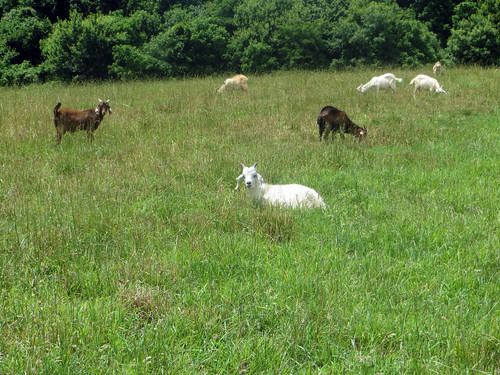At the recent consignor's meeting in Virginia, it was decided to split the 2014 Western Maryland Pasture-Based Meat Goat Performance Test into two phases.
After a 13-day adjustment period, the bucks would face an internal parasite challenge in the first phase of the test (days 0-42). They would graze cool season grass pastures that are pre-infected by untreated sheep. At the end of the first phase (day 42), all of the goats would be given a 0.5 g bolus of copper oxide wire particles.
In the second phase of the test (day 42-84), the goats would be challenged for growth. They would graze clean, taller, annual pastures. The central laneway would still provide an opportunity for re-infection, but the lower overall risk of parasite re-infection should provide a better opportunity for growth.
Beginning with day 42, the goats would also be limit fed a good quality grass hay. Hay would be fed at a rate of approximately 2% of body weight (about 1 lb. per goat). Feeder space would be adequate to allow all goats to eat at one time.
While forage quality and quantity are usually not lacking in the test, dry matter intake is a limiting factor and some goats simply do not consume enough dry matter to meet their nutritional requirements for growth. With regards to growth (ADG), energy (TDN) is probably the most limiting nutrient.
Several other changes were proposed to the test. It was suggested that the minimum weight be increased to 40 lbs. It is currently 35 lbs. This change will not take effect until the 2015 test. However, for the 2014 test, the minimum starting weight of 35 lbs. will be strictly enforced. Goats weighing less than 35 lbs. will be refused entry to the test.
When selecting goats for the 2014 test, producers will want to select goats that will weigh a minimum of 35 lbs. upon delivery to the test site. This means that they should probably weigh at least 40 lbs. to allow for shrink and scale differences.
It was suggested that the minimum weight for sale bucks be 50 lbs. This suggestion was not implemented.
A requirement for on-farm performance testing was also discussed. It was suggested that only bucks with adjusted weaning weight ratios above 100 percent be consigned to the test. Many producers are currently sending their on-farm data to Kentucky State University or Oklahoma State University for tabulation. This idea will be explored further in the months ahead.
After a 13-day adjustment period, the bucks would face an internal parasite challenge in the first phase of the test (days 0-42). They would graze cool season grass pastures that are pre-infected by untreated sheep. At the end of the first phase (day 42), all of the goats would be given a 0.5 g bolus of copper oxide wire particles.
 |
| Phase I (day 0-42): parasite challenge |
In the second phase of the test (day 42-84), the goats would be challenged for growth. They would graze clean, taller, annual pastures. The central laneway would still provide an opportunity for re-infection, but the lower overall risk of parasite re-infection should provide a better opportunity for growth.
Beginning with day 42, the goats would also be limit fed a good quality grass hay. Hay would be fed at a rate of approximately 2% of body weight (about 1 lb. per goat). Feeder space would be adequate to allow all goats to eat at one time.
While forage quality and quantity are usually not lacking in the test, dry matter intake is a limiting factor and some goats simply do not consume enough dry matter to meet their nutritional requirements for growth. With regards to growth (ADG), energy (TDN) is probably the most limiting nutrient.
 |
| Phase II (day 42-84): growth challenge |
Several other changes were proposed to the test. It was suggested that the minimum weight be increased to 40 lbs. It is currently 35 lbs. This change will not take effect until the 2015 test. However, for the 2014 test, the minimum starting weight of 35 lbs. will be strictly enforced. Goats weighing less than 35 lbs. will be refused entry to the test.
When selecting goats for the 2014 test, producers will want to select goats that will weigh a minimum of 35 lbs. upon delivery to the test site. This means that they should probably weigh at least 40 lbs. to allow for shrink and scale differences.
It was suggested that the minimum weight for sale bucks be 50 lbs. This suggestion was not implemented.
A requirement for on-farm performance testing was also discussed. It was suggested that only bucks with adjusted weaning weight ratios above 100 percent be consigned to the test. Many producers are currently sending their on-farm data to Kentucky State University or Oklahoma State University for tabulation. This idea will be explored further in the months ahead.











